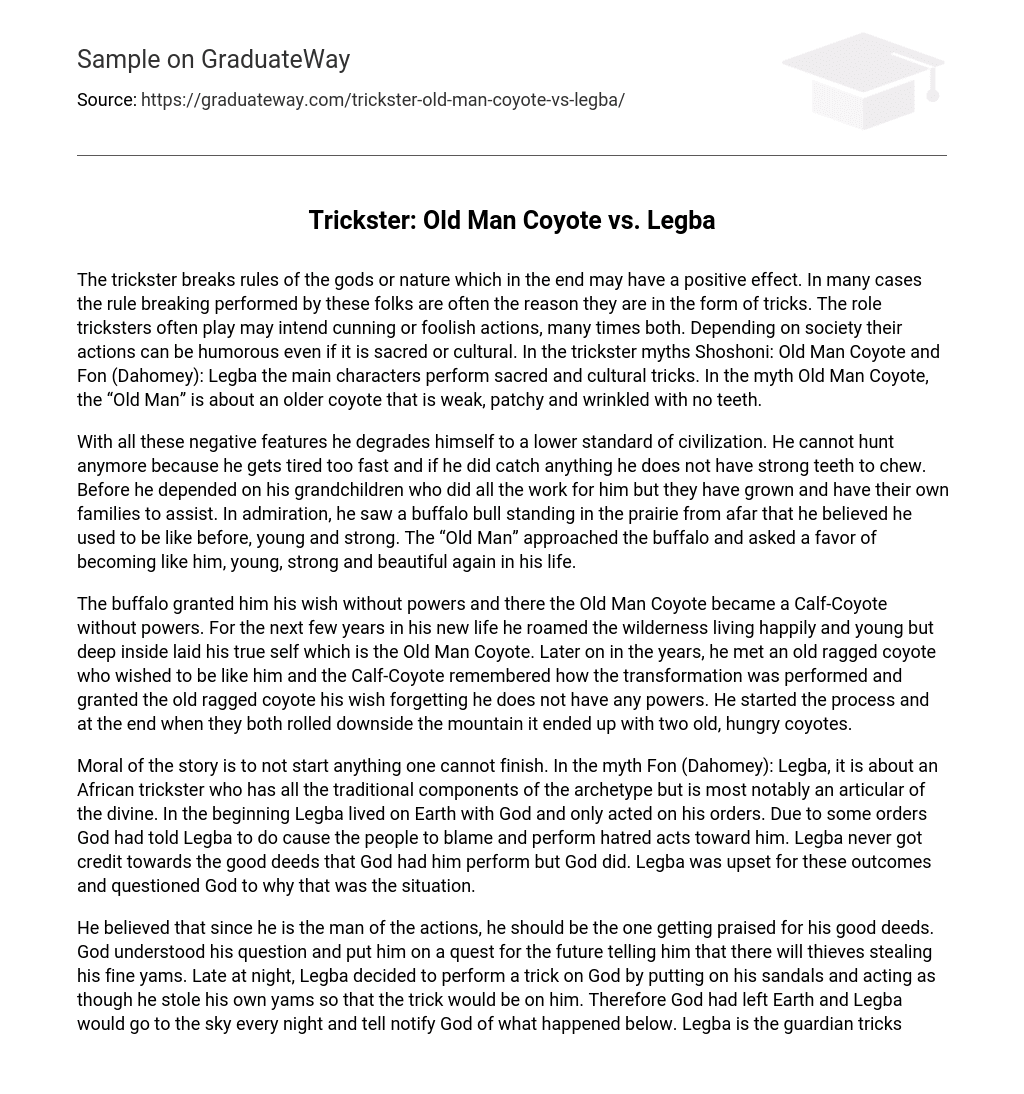The trickster breaks rules of the gods or nature which in the end may have a positive effect. In many cases the rule breaking performed by these folks are often the reason they are in the form of tricks. The role tricksters often play may intend cunning or foolish actions, many times both. Depending on society their actions can be humorous even if it is sacred or cultural. In the trickster myths Shoshoni: Old Man Coyote and Fon (Dahomey): Legba the main characters perform sacred and cultural tricks. In the myth Old Man Coyote, the “Old Man” is about an older coyote that is weak, patchy and wrinkled with no teeth.
With all these negative features he degrades himself to a lower standard of civilization. He cannot hunt anymore because he gets tired too fast and if he did catch anything he does not have strong teeth to chew. Before he depended on his grandchildren who did all the work for him but they have grown and have their own families to assist. In admiration, he saw a buffalo bull standing in the prairie from afar that he believed he used to be like before, young and strong. The “Old Man” approached the buffalo and asked a favor of becoming like him, young, strong and beautiful again in his life.
The buffalo granted him his wish without powers and there the Old Man Coyote became a Calf-Coyote without powers. For the next few years in his new life he roamed the wilderness living happily and young but deep inside laid his true self which is the Old Man Coyote. Later on in the years, he met an old ragged coyote who wished to be like him and the Calf-Coyote remembered how the transformation was performed and granted the old ragged coyote his wish forgetting he does not have any powers. He started the process and at the end when they both rolled downside the mountain it ended up with two old, hungry coyotes.
Moral of the story is to not start anything one cannot finish. In the myth Fon (Dahomey): Legba, it is about an African trickster who has all the traditional components of the archetype but is most notably an articular of the divine. In the beginning Legba lived on Earth with God and only acted on his orders. Due to some orders God had told Legba to do cause the people to blame and perform hatred acts toward him. Legba never got credit towards the good deeds that God had him perform but God did. Legba was upset for these outcomes and questioned God to why that was the situation.
He believed that since he is the man of the actions, he should be the one getting praised for his good deeds. God understood his question and put him on a quest for the future telling him that there will thieves stealing his fine yams. Late at night, Legba decided to perform a trick on God by putting on his sandals and acting as though he stole his own yams so that the trick would be on him. Therefore God had left Earth and Legba would go to the sky every night and tell notify God of what happened below. Legba is the guardian trickster of crossroads and entrances.
He speaks of many languages and has the power to remove obstacles and provide opportunities due to his connection with the gods. He is the first consultation before any communication with the gods which play a big role when it comes to tricksters because stories can be twisted in between communications. These two trickster myths are different because one comes from a cultural aspect and the other is from a sacred aspect. The Old Man Coyote is from a cultural aspect because of the Shoshoni Indian tribe it was derived from.
The buffalo played a big role to that cultures storytelling because they looked at the buffalo as a cultural trait; they used them for shelter, clothing and food. The West African myth Legba is a sacred myth because it deals with the communication between God and a body on Earth who is appointed to that position that ends up being a trickster. African folklore is passed down from generation to generation and the stories are very important to the traditions of the Africans. Tricksters and animals are common in their folklore and they can be entertaining as well serve a purpose to teach a lesson.
In this case, it was a trickster myth about a messenger between the world and the supreme God. These two trickster myths are similar for what they are categorized by, which is a subject in the myth is playing a trick on themselves and another person or society. They both come from two different cultural backgrounds which are Shoshoni Indian and West African. They are both definitely influenced by the strong history behind both cultures which is important to the significance to each tale. In summation, the trickster breaks rules of the gods or nature which in the end may have a positive effect.
In many cases the rule breaking performed by these folks are often the reason they are in the form of tricks. In the Old Man Coyote it happens to be a foolish trick he put on himself and the other coyote and in Legba is happens to be a cunning trick he plays on God and society to save his image.
Works Cited
“African Folklore and Legends. ” African Folklore, Myths and Legends. N. p. , n. d. Web. 20 Nov. 2012. <http://www. victoriafalls-guide. net/african-folklore. html>. “Shoshone Indian Fact Sheet. ” Facts for Kids: Shoshone Indians (Shoshoni). N. p. , n. d. Web. 20 Nov. 2012. <http://www. bigorrin. org/shoshone_kids. htm>.





